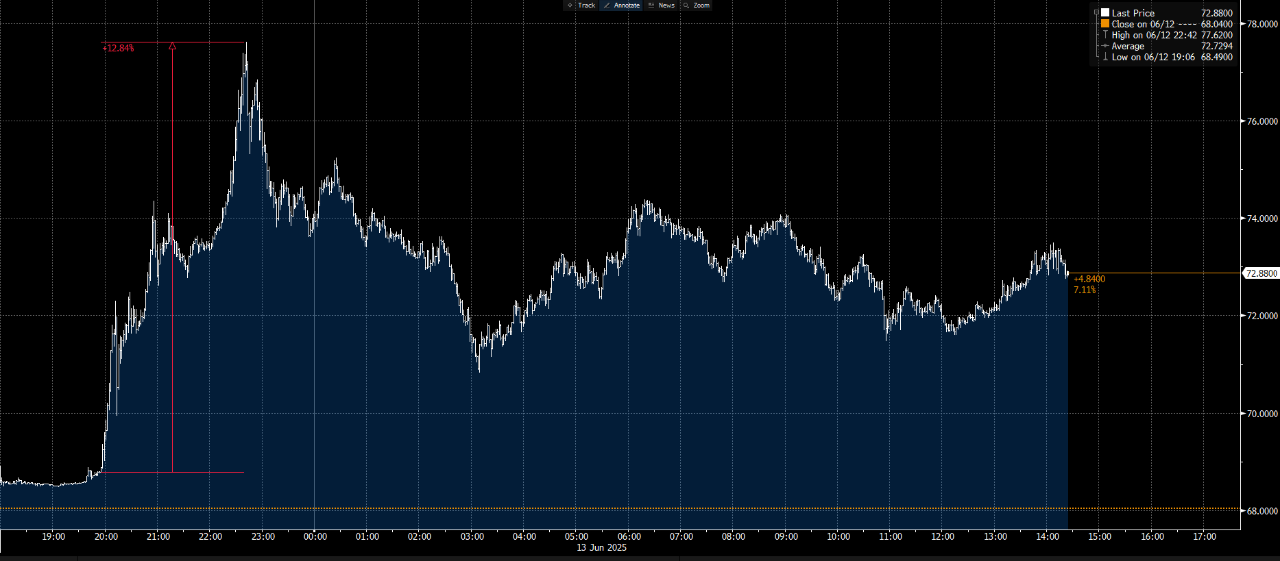Myles Zyblock – Volatility update
A (c)rude awakening
June 13, 2025
Myles Zyblock
S&P 500 futures dropped by almost 2% over night on news that Israel's defense forces struck targets inside of Iran. The price for crude oil, among the most sensitive assets to Middle East developments, surged by about 13% (see chart below). Crude has settled back alongside various measures of financial market volatility since that initial volatility spike. At the time of writing, WTI was holding near a 7.1% gain while the S&P 500 was down by close to 1.1%.
Figure 1: WTI Crude Oil Price Action

Peace is preferred to conflict, with the latter being a sad, important, and repetitive part of human history. Immediate financial market volatility on the breaking news of conflict is common. The S&P 500 initially dropped by 1.1% when Iraq invaded Kuwait in 1990, and by 4.9% during the September 11 terrorist attacks on U.S. soil. Sell-offs can end quickly, lasting as little as one day, but on average they have persisted for about three weeks when measured using all major conflicts since the December 1941 attack on Pearl Harbor. Using this same history, we found that the U.S. equity market posted a positive return one year later 72% of the time, with a typical gain of 12.7%.
Bottom line: While the onset of conflict is unsettling, financial markets tend to calm down within a few weeks or less. In times like this, it is important to maintain a long-term focus.
Myles Zyblock BA (Hons.), MA, CFA
Chief Investment Strategist
Commissions, trailing commissions, management fees and expenses may be associated with mutual fund investments. Please read the prospectus before investing. Mutual funds are not guaranteed or insured by the Canada Deposit Insurance Corporation or any other government deposit insurer; their values change frequently, and past performance may not be repeated.
This publication is provided for information purposes only. It is not to be relied upon as financial, tax or investment advice or guarantees about the future, nor should it be considered a recommendation to buy or sell. Information contained in this document, including information relating to interest rates, market conditions, tax rules, and other investment factors, are subject to change without notice, and The Bank of Nova Scotia is not responsible to update this information. All third-party sources are believed to be accurate and reliable as of the date of publication, and The Bank of Nova Scotia does not guarantee its accuracy or reliability. Readers should consult their own professional advisor for specific financial, investment and/or tax advice tailored to their needs to ensure that individual circumstances are considered properly and action is taken based on the latest available information. This publication may contain forward-looking statements based on current expectations and projections about future general economic factors. Forward-looking statements are subject to inherent risks and uncertainties which may be unforeseeable and such expectations and projections may be incorrect in the future. Forward-looking statements are not guarantees of future performance and you should avoid placing undue reliance upon them. This publication and all the information, opinions and conclusions contained herein are protected by copyright. This publication may not be reproduced in whole or in part without the prior express consent of The Bank of Nova Scotia.
To the extent this document contains information or data obtained from third party sources, it is believed to be accurate and reliable as of the date of publication, but Scotia Global Asset Management does not guarantee its accuracy or reliability.
Scotia Global Asset Management is a business name used by 1832 Asset Management L.P., a limited partnership, the general partner of which is wholly owned by Scotiabank.
Scotiabank® includes The Bank of Nova Scotia and its subsidiaries and affiliates, including 1832 Asset Management L.P. and Scotia Securities Inc.
ScotiaFunds® are managed by Scotia Global Asset Management. ScotiaFunds are available through Scotia Securities Inc. and from other dealers and advisors. Scotia Securities Inc. is wholly owned by The Bank of Nova Scotia and is a member of the Canadian Investment Regulatory Organization.
® Registered trademarks of The Bank of Nova Scotia, used under licence.
© Copyright 2025 The Bank of Nova Scotia. All rights reserved.

